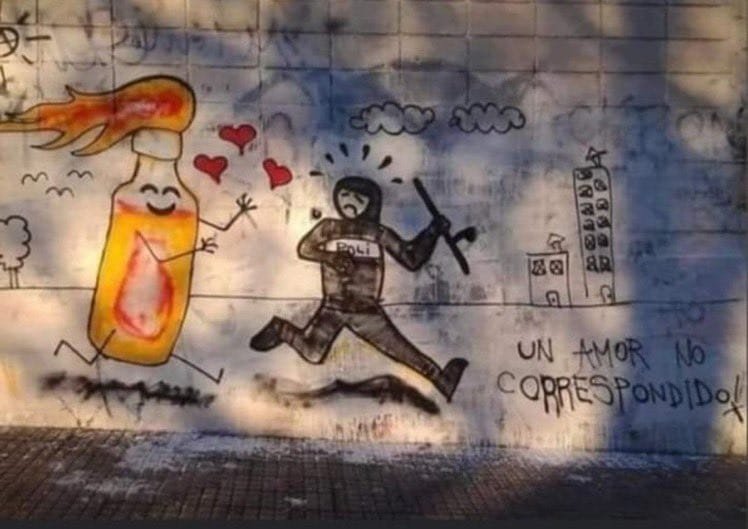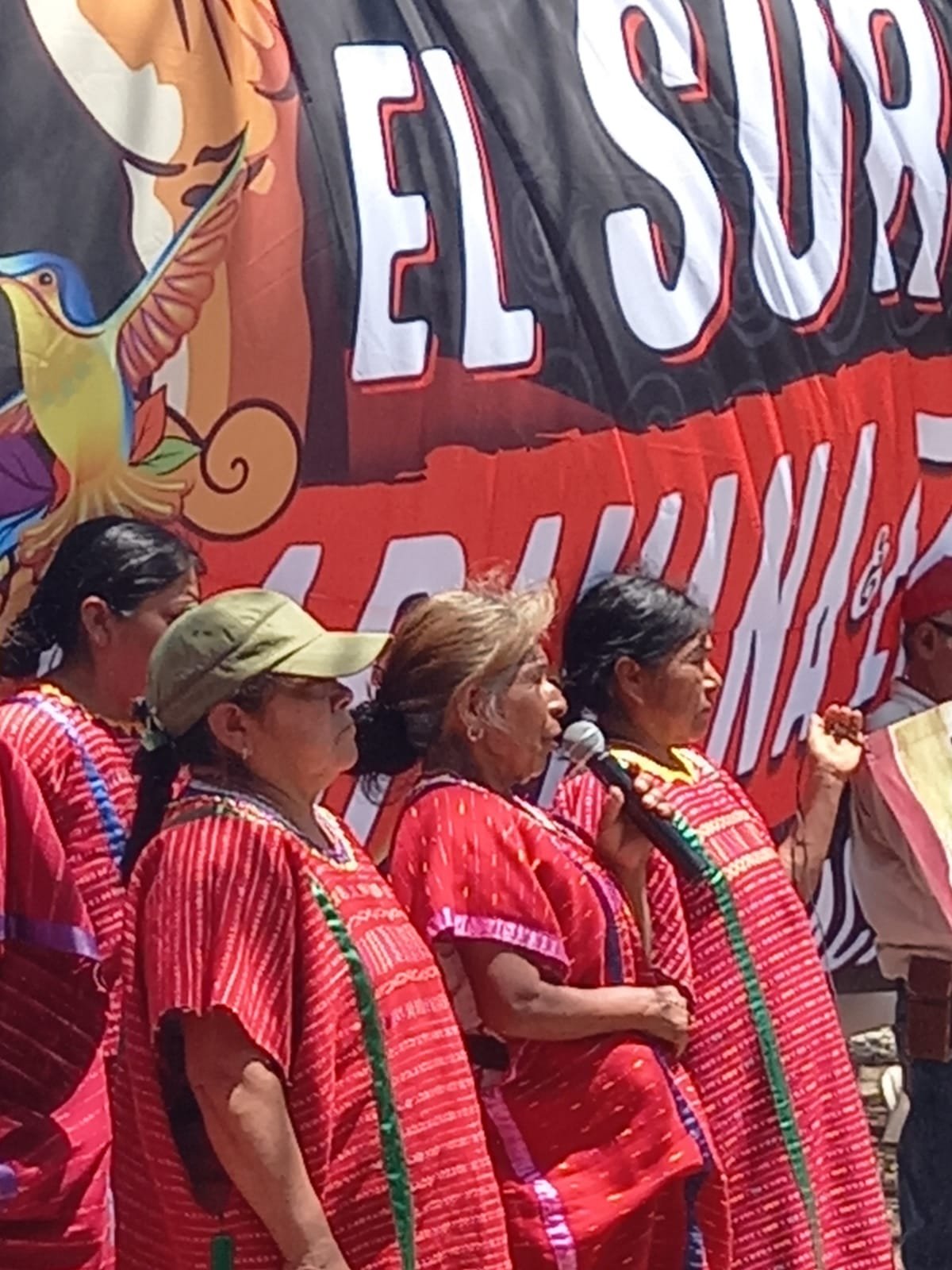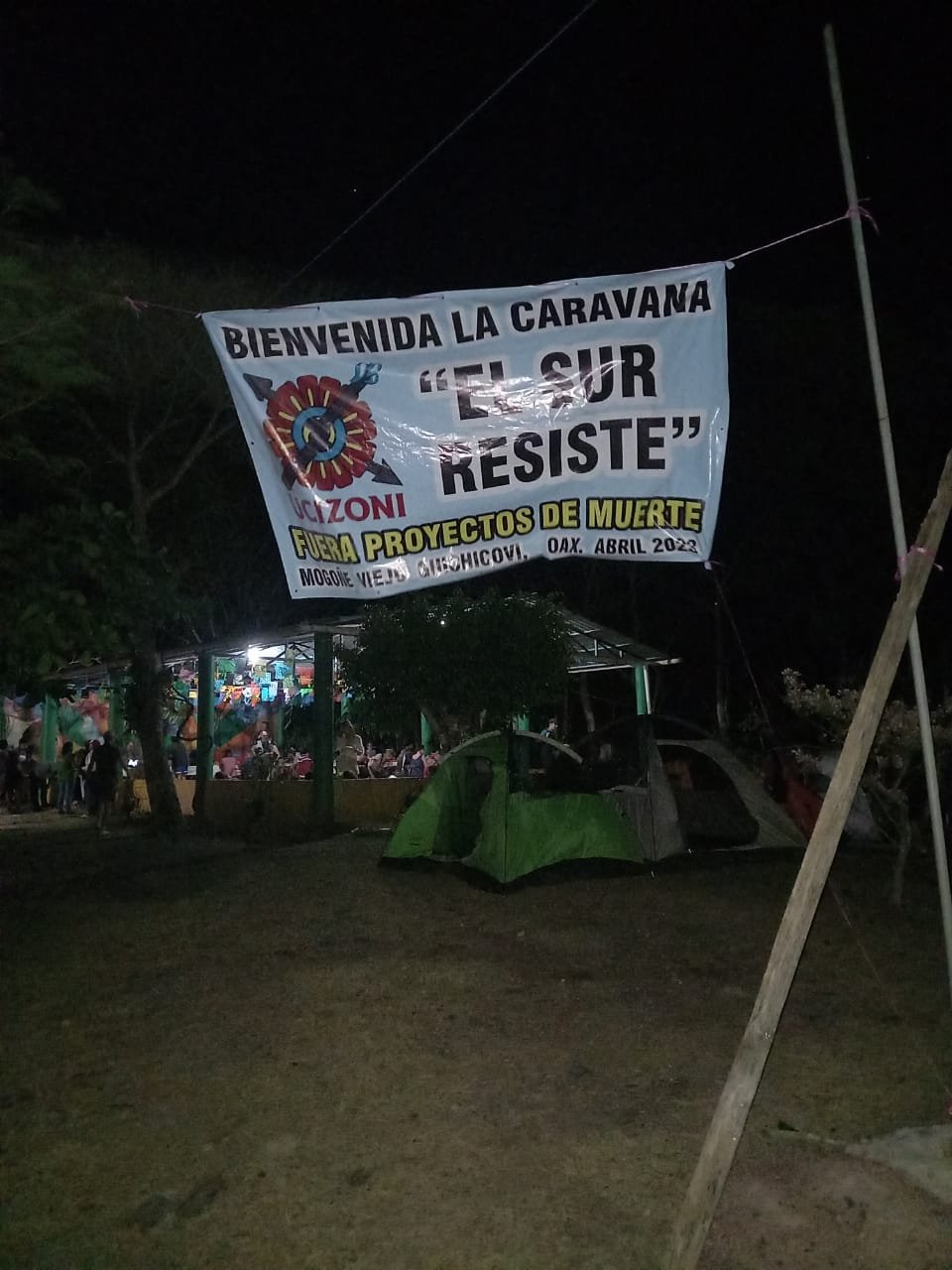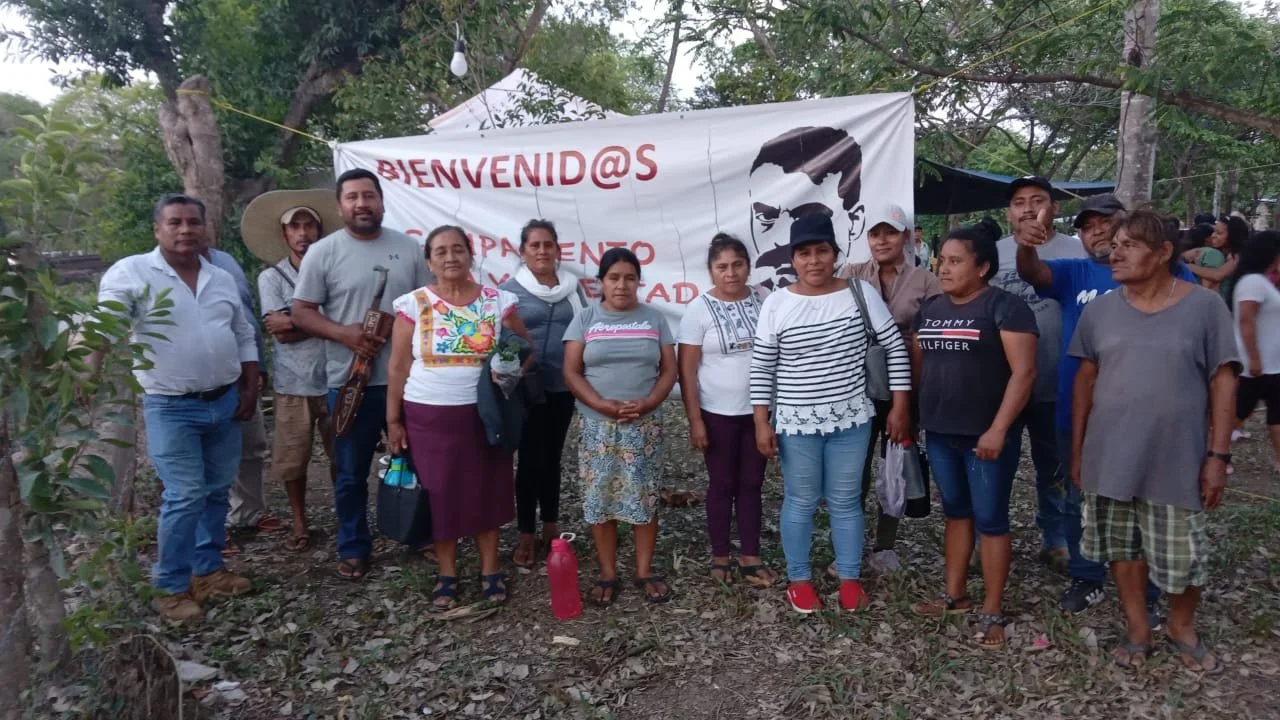Resisting “Death Projects”: An Interview With Carlos Beas Torres
Cliquea aquí por la versíon en español / Click here to read the Spanish version of this article.
This article was produced and edited by Talking Wings. The interview was conducted by Alejandra Altamirano Salazar and translated by Maria Magro.
Solidarity demonstration in Oaxaca. (Photo: UCIZONI)
On April 28, the Mexican military and police invaded and evicted the “Tierra y Libertad” (Land and Liberty) camp that the Indigenous Mixe community of Mogoñé Viejo had maintained for 61 days. The camp was blocking the construction of the high speed rails that form part of the Interoceanic Corridor of the Isthmus of Tehuantepec (also known as CIIT). This megaproject, financed by the Mexican government and international corporations, is seeking to turn the Isthmus of Tehuantepec, the narrowest part of Mexico, into a the “new Panama Canal.”
Connecting the ports of the Gulf of Mexico and the Pacific, the CIIT is just one of the many infrastructure projects implemented by President Andrés Manuel López Obrador that are violating the rights of Indigenous communities and nature. The pipelines, like those being built by TC Energy Corporation (TransCanada), high speed rails, and industrial parks, are invading Indigenous territory and fomenting environmental destruction. However, communities like Mogoñé Viejo continue to resist. Since April 28, they have begun barricading additional highways.
The following is an interview with Carlos Beas Torres, a member of the Unión de Comunidades Indígenas de la Zona Nortel del Istmo de Tehuantepec (Union of Indigenous Communities from the North of the Isthmus or UCIZONI), an organization that has resisted the CIIT since its conception and forms part of the “El Sur Resiste” (The South Resists) Caravan.
What is your name and organization?
I am Carlos Beas Torres. I am part of the coordination team of the Union of Indigenous Communities of the North Zone of the Isthmus of Tehuantepec (UCIZONI), an organization that is already 40 years old, and is located in the southeast of Mexico, between the states of Oaxaca, Veracruz and Chiapas, also very close to Guatemala. We are an organization that brings together more than sixty-five Indigenous peoples, from the Ayuukjä'äy (Ayuuk or Mixe), Binnizá (Zapoteco), Zoque Angpøn or O'de püt, Huaves or Ikoots, and Chinanteco nations. Also, in UCIZONI, there are groups of Afro-descendants.
We are a pleuritic organization, independent of political parties, independent of churches. We are a free and autonomous organization.
Can you explain more about the territory where you live, the rivers found there, and why it needs to be protected?
Our region is an area where the last great tropical forests of Mexico endure, as well as cloud forests. One of the largest rivers in Mexico is born here, the Coatzacoalcos River, known here as the río del corte.
We already have very serious problems. The introduction of large livestock programs has caused the destruction of the forest. Also, the use of agrochemicals has caused the destruction of rivers. The lack of sewage management in cities is causing a lot of pollution in our rivers. This all has to do with development, cities, industries, livestock, and intensive plantations, and is getting even more serious because the amount of our seasonal rains have decreased, we have extended droughts. We are facing an emergency; in spite of the fact that we live in an area where there is still a tropical rainforest.
So, there is already a crisis, due to the lack and scarcity of water, and now they are imposing a megaproject on us, which means industrial parks, which means that they are going to use even more water.
What is UCIZONI's mission, and what are you working on at the moment?
Since it [UCIZONI] started, it has had as its main objectives the defense of the rights of Indigenous communities, the defense of the rights of Mother Earth, as well as a resilient defense of the rights of Indigenous women and girls - the sector of the population suffering the greatest violence, assaults, and poverty. That is our great mandate as an organization, and within that mandate, for many years, we have also had to defend our own territory.
Street art from the “Tierra y Libertad” (Land and Liberty) encampment. (Photo: UCIZONI)
We live in the narrowest part of Mexico, which is an interoceanic corridor. It has existed as a corridor for hundreds of thousands of years. But in recent times, governments, large companies, and large transnational corporations are looking for a way to use this interoceanic corridor in order to increase the shipping of merchandise and hydrocarbons. For example, two gas pipelines are currently being considered, one involving a Canadian company, TransCanada (TC Energy Corporation), seeking to transport gas from the state of Texas to southeastern Mexico, where the construction of another gas pipeline is being proposed by two North American companies, Mirage Energy and Hemisphere Northern Logistics.
It is a danger we have already encountered. There are oil pipelines here that have caused serious environmental damage. In December of last year, we suffered three weeks of environmental crisis due to an ammonia leak. More than 1,500 families in our region were relocated.
Expressions of solidarity with the land defenders of Mogoñé Viejo from community members in Chiapas, Switzerland, and Oaxaca. (Photos: UCIZONI)
So, this megaproject, which includes the construction of more than ten industrial parks, will create an intense strain on our rivers, streams, and water sources. They are also building high speed railway lines to transport goods, as well as expanding ports, destroying many trees, and destroying mountains.
We are also fighting against this megaproject, the Tehuantepec Isthmus Interoceanic Corridor, where American and Canadian capital is involved.
And there was no consultation with the local communities?
There were no consultations under international protocols, and it was not culturally representative of the culture and traditions of the Indigenous communities. There were some informative meetings, but they were shams, set up simply to say that the Indigenous population had already been consulted. They were misrepresentations: for example, for the Ayuuk nation, the consultation was carried out sixty-five kilometers from the towns affected by the railway. In other words, the meeting was carried out far from the towns which would be the most directly affected.
So, the most serious situation at this moment is the criminalization of the movement and of you personally. Can you tell me more about this situation?
In the last three months, this megaproject has been under the control of the Secretary of the Navy, a very violent military body in Mexico, now intimidating the communities. It is the authority that is pressuring the towns to carry out the work.
Scenes from the “Tierra y Libertad” (Land and Liberty) encampment. (Photos: UCIZONI)
And along with these threats, we have also received threats from organized crime groups, from drug cartels, who protect the companies for a price. But they are also criminalizing us, they are accusing us of being responsible for the fact that the project cannot be carried out, for stopping the work. They are going so far as to say we are doing it because we receive money from organized crime. Which is very dangerous, very delicate, because it misrepresents us as criminals and not guardians of the territory. It is the strategy of the government to discount our efforts, to minimize the fight, to attack us.
So organized crime is in the equation, but is it being pointed in the wrong direction?
Until now, organized crime has been working together with the companies. But, to provoke and justify the repression, the government is saying that organized crime is financing us to hinder their work. So, this is how we have been criminalized, and it is what we have recently witnessed.
It is often thought that all foreign projects are seeking progress, but in the end, they have a double face.
Yes, at the end of the day, it is important that it be known that this megaproject has a social and environmental cost for the Indigenous peoples of the Isthmus of Tehuantepec, for their rights, and for their future, for their lives. For this reason, we call it a death project.
The Escazú Agreement is an international treaty which Mexico recognizes. It promotes protection for the environment and sustainable development. Do you believe that this accord is being applied, or is it simply being put aside?
The problem with the Escazú Agreement is that even if the Mexican government has signed the agreement, there is still no procedure on how to apply it, that is, there is still no protocol on how it should be applied. And this is not only happening in Mexico. It is occurring in other countries that subscribe to international treaties, but where there are no international mechanisms to make them effective, including protection measures for environmental defenders.
Can you tell us more about what’s happening now on the ground?
After two attempted evictions, taking place March 21 and April 28 against the Indigenous farmers from Mogoñe Viejo, who had established the “Tierra y Libertad” (Land and Liberty) encampment, the fight continues. The people who were arrested have already been freed. However, we know that 14 of our comrades are currently being charged. We are thus experiencing extreme repression. We are calling for international and national solidarity to support the comrades from Mogoñe Viejo.
Scenes from the “Tierra y Libertad” (Land and Liberty) encampment. (Photos: UCIZONI)
We also want to inform you that they announced this week that they started the construction of a pipeline from Coatzacoalcos to Tuxpan, without an environmental impact assessment. This project is also being built by Transcanada. So, we are witnessing this Canadian company threaten the “Laguna del Ostion” estuary, in the south of the state of Veracruz.
How do you think we can help UCIZONI?
Spreading the word is very important because we are being isolated, the information regarding what is happening here, silenced. In many places, no one is aware of what is currently happening: the escalating situation of criminalization, the repercussions of the Interoceanic Corridor and the interests of TransCanada, building gas pipelines. The original peoples of Canada and the United States have also had intense struggles against the impacts of these projects. It is important to know that in Mexico we are also protesting against this company.
Is there anything else you would like to add?
The focus, the main point, is that big capitalism, big companies, and the system that governs globally continue to advance projects to destroy the environment and Indigenous cultures. It is necessary that the peoples of different regions and cultures work within their communities to fight against this paradigm that promotes the death of our planet.
Scene from the “Tierra y Libertad” (Land and Liberty) encampment. (Photo: UCIZONI)
We inhabit a planet that is already on its deathbed, we inhabit a planet that, due to climate change, is already expressing serious environmental crises. It is necessary for humanity, it is necessary for communities to recognize the challenge and focus our strength in order to face this tragedy. Maybe it is our last chance, maybe it is our last chance to stop the destruction of the planet, the destruction produced by theft, by the interests of a minority only interested in money, not in life.
How to Support
If you would to send a letter of solidarity to Carlos Beas Torres, the Mogoñé Viejo community, or UCIZONI, please fill out this form:














